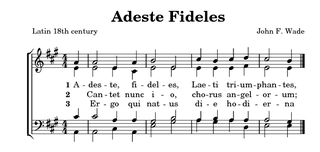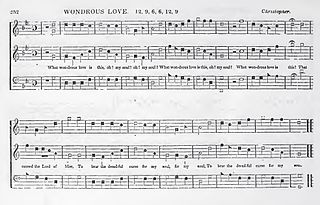An anthem is a musical composition of celebration, usually used as a symbol for a distinct group, particularly the national anthems of countries. Originally, and in music theory and religious contexts, it also refers more particularly to short sacred choral work and still more particularly to a specific form of liturgical music. In this sense, its use began c. 1550 in English-speaking churches; it uses English language words, in contrast to the originally Roman Catholic 'motet' which sets a Latin text.

A hymn is a type of song, and partially synonymous with devotional song, specifically written for the purpose of adoration or prayer, and typically addressed to a deity or deities, or to a prominent figure or personification. The word hymn derives from Greek ὕμνος (hymnos), which means "a song of praise". A writer of hymns is known as a hymnist. The singing or composition of hymns is called hymnody. Collections of hymns are known as hymnals or hymn books. Hymns may or may not include instrumental accompaniment.

"Wilhelmus van Nassouwe", usually known just as "Wilhelmus", is the national anthem of both the Netherlands and the Kingdom of the Netherlands. It dates back to at least 1572, making it the oldest national anthem in use today, provided that the latter is defined as consisting of both a melody and lyrics. Although "Wilhelmus" was not recognized as the official national anthem until 1932, it has always been popular with parts of the Dutch population and resurfaced on several occasions in the course of Dutch history before gaining its present status. It was also the anthem of the Netherlands Antilles from 1954 to 1964.
Lyrics are words that make up a song, usually consisting of verses and choruses. The writer of lyrics is a lyricist. The words to an extended musical composition such as an opera are, however, usually known as a "libretto" and their writer, as a "librettist". The meaning of lyrics can either be explicit or implicit. Some lyrics are abstract, almost unintelligible, and, in such cases, their explication emphasizes form, articulation, meter, and symmetry of expression. Rappers can also create lyrics that are meant to be spoken rhythmically rather than sung.

"My Country, 'Tis of Thee", also known as simply "America", is an American patriotic song, the lyrics of which were written by Samuel Francis Smith. The song served as one of the de facto national anthems of the United States before the adoption of "The Star-Spangled Banner" as the official U.S. national anthem in 1931. The melody used is the same as that of the national anthem of the United Kingdom, "God Save the King".

A hymnal or hymnary is a collection of hymns, usually in the form of a book, called a hymnbook. They are used in congregational singing. A hymnal may contain only hymn texts ; written melodies are extra, and more recently harmony parts have also been provided.
A national anthem is a patriotic musical composition symbolizing and evoking eulogies of the history and traditions of a country or nation. The majority of national anthems are marches or hymns in style. American, Central Asian, and European nations tend towards more ornate and operatic pieces, while those in the Middle East, Oceania, Africa, and the Caribbean use a more simplistic fanfare. Some countries that are devolved into multiple constituent states have their own official musical compositions for them ; their constituencies' songs are sometimes referred to as national anthems even though they are not sovereign states.
A lyricist is a person who writes lyrics, as opposed to a composer, who writes the song's music which may include but not limited to the melody, harmony, arrangement and accompaniment.
Parody music, or musical parody, involves changing or copying existing musical ideas, and/or lyrics, or copying the particular style of a composer or performer, or even a general style of music.
A contrafact is a musical work based on a prior work. The term comes from classical music and has only since the 1940s been applied to jazz, where it is still not standard. In classical music, contrafacts have been used as early as the parody mass and In Nomine of the 16th century. More recently, Cheap Imitation (1969) by John Cage was produced by systematically changing notes from the melody line of Socrate by Erik Satie using chance procedures.
Songs of Syon: A Collection of Hymns and Sacred Poems Mostly Translated from Ancient Greek, Latin and German Sources was produced by George Ratcliffe Woodward in 1904. In 1908, a new and enlarged edition was produced, with the title Songs of Syon: A Collection of Psalms, Hymns and Spiritual Songs for Public and Private Use. While the first edition had 201 items, this later edition had 431. Words and music were published separately. A third edition followed in 1910. A fourth edition, revised and enlarged, came out in 1923. This was primarily a reprint of the third edition, with musical errors corrected on the advice of Dr.Charles Wood. In a few cases, "finer melodies, or better harmonies, have been substituted." The hymnal was described by the writer of Woodward's Church Times obituary as "the finest hymn book, both as regards words and music, ever produced in England."
Hymns are an important part of the history and worship of the Church of Jesus Christ of Latter-day Saints.

A hymn tune is the melody of a musical composition to which a hymn text is sung. Musically speaking, a hymn is generally understood to have four-part harmony, a fast harmonic rhythm, with or without refrain or chorus.
Dives and Lazarus is traditional English folk song listed as Child ballad 56 and number 477 in the Roud Folk Song Index. It is considered a Christmas carol and based on the parable of the rich man and Lazarus. The song traditionally used a variety of tunes, but one particular tune, published by Lucy Broadwood in 1893 and used in other traditional songs, inspired many notable works and appeared in several pieces composed by Ralph Vaughan Williams.

Comedy music or musical comedy is a genre of music that is comic or humorous in nature. Its history can be traced back to the first century in ancient Greece and Rome, moving forward in time to the Medieval Period, Classical and Romantic eras, and the 20th century. Artists in the 20th century include Allan Sherman, Frank Zappa, Tiny Tim, Barenaked Ladies, Randy Newman, and "Weird Al" Yankovic. Artists in the 21st century include Tenacious D, Flight of the Conchords, The Lonely Island, Ninja Sex Party and The Axis of Awesome.
Hotaru no Hikari is a Japanese song incorporating the tune of Scottish folk song Auld Lang Syne with completely different lyrics by Chikai Inagaki, first introduced in a collection of singing songs for elementary school students in 1881. The swapping of lyrics without substantial change to the music is known as contrafactum. The words describe a series of images of hardships that the industrious student endures in his relentless quest for knowledge, starting with the firefly’s light, which the student uses to keep studying when he has no other light sources. It is commonly heard during graduation ceremonies and at the end of the school day. Many stores and restaurants play it to usher customers out at the end of a business day. On the very popular Japanese New Year's Eve TV show, NHK's Kōhaku Uta Gassen, it has become a tradition for all the performers to sing Hotaru no Hikari as the last song. Tokyo Disneyland and Tokyo Disney Sea here is Tokyo Disney Resort for Countdown Party's from New Year's Eve Park show, "New Day, New Dream". Another song from the same period and used at graduation ceremonies thought to be based on a Scottish folk song is "Aogeba Tōtoshi".
The original use of the term "parody" in music referred to re-use for wholly serious purposes of existing music. In popular music that sense of "parody" is still applicable to the use of folk music in the serious songs of such writers as Bob Dylan, but in general, "parody" in popular music refers to the humorous distortion of musical ideas or lyrics or general style of music.

"What Wondrous Love Is This" is a Christian folk hymn from the American South. Its text was first published in 1811, during the Second Great Awakening, and its melody derived from a popular English ballad. Today it is a widely known hymn included in hymnals of many Christian denominations.

"Papirosn" is a Yiddish song that was written in the 1920s. The song tells the story of a Jewish boy who sells cigarettes to survive on the streets. He depicts his tragic fate; having lost his parents, his younger sister has died on the bench, and eventually he loses his own hope.
Hymnody in continental Europe developed from early liturgical music, especially Gregorian chant. Music became more complicated as embellishments and variations were added, along with influences from secular music. Although vernacular leisen and vernacular or mixed-language carols were sung in the Middle Ages, more vernacular hymnody emerged during the Protestant Reformation, although ecclesiastical Latin continued to be used after the Reformation. Since then, developments have shifted between isorhythmic, homorhythmic, and more rounded musical forms with some lilting. Theological underpinnings influenced the narrative point of view used, with Pietism especially encouraging the use of the first person singular. In the last several centuries, many songs from Evangelicalism have been translated from English into German.







